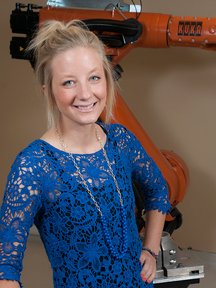
Rachel Surowiec,
MSc
Research Scientist, Consultant
Rachel has been an integral part of the SPRI team since she started here in 2011. Her specific research focus has included the clinical validation of quantitative MRI techniques such as T2 mapping for early detection of Osteoarthritis (OA). The purpose of this research is to map articular cartilage, which could allow for a non-invasive measurement of the onset and progression of OA. This type of knowledge would then enable advancements in both pre- and post-operative surgical planning. The ability to assess cartilage morphology and integrity in a non-operative setting could cut down on the need for second look arthroscopies, as well as allow for easier evaluation of novel cartilage restoration and treatment methods. Implications for quantitative MRI are vast, and as such, Rachel’s collaborative research goals consist of using this technique in the continued evaluation of other joints and structures. While at SPRI, Rachel has been a key component in the development and maintenance of international collaborative efforts, both in academia as well as industry. She has played a vital role in numerous clinically relevant and innovative projects at SPRI; participating at all levels of the study, including project design, planning and preparation, as well as execution.
In 2009, Rachel received her Bachelor of Science degree in Exercise Science and Kinesiology from Ball State University, while also minoring in Coaching. While attending Ball State, Rachel was a member of the University’s three time NCAA Academic All-American Women’s Tennis Team, and was elected Captain in her final year. It was because of her time on the tennis team that Rachel initially cultivated an interest in biomechanics, as she was able to be a subject in a motion capture analysis of her tennis serve, in which the forces, torques, and angles of her swing mechanics were evaluated. Following that experience, she devoted her spare time to the Biomechanics Research Laboratory, aiding in gait analysis and sports performance testing using motion capture and EMG data. For her undergraduate internship Rachel had the ability to work in the Notre Dame strength and conditioning room, where she predominantly assisted with the football team. This position not only allowed her to gain valuable knowledge and experience working with high level athletes, but the focus her internship placed on sports performance and injury prevention was instrumental in paving her path to SPRI.
After receiving her Bachelor’s degree, Rachel was then accepted into the Biomechanics Master of Science degree program at Ball State University. There she returned to the Biomechanics Laboratory, completing an assistantship in the gait analysis of both healthy athletic adults as well as orthopaedic pediatric patients. Here she gained a wealth of experience in the benefits of collaborative efforts by working on a team that included physicians, physical therapists, athletic trainers, coaches and athletes. Her team’s goal was to improve performance, shorten the recovery phase, and prevent injury. While working, Rachel completed her thesis, which was entitled “The Effects of Whole Body Vibration on the Wingate Test for Anaerobic Power when Applying Individualized Frequencies.” In her paper, Rachel evaluated the tonic vibration reflex phenomena in elite cyclists, in order to observe a training response in an already highly trained patient cohort. Rachel additionally participated in projects examining muscle response and posture on various seating surfaces as well as the effects that fatigue and load carriage had on various elements of human motion, in particular common mechanisms of musculoskeletal injury.

